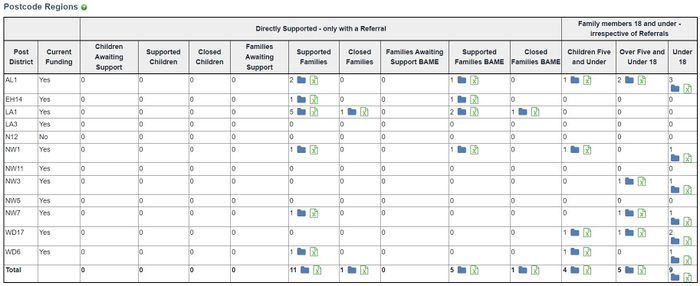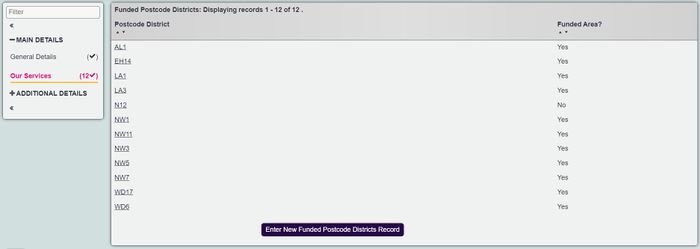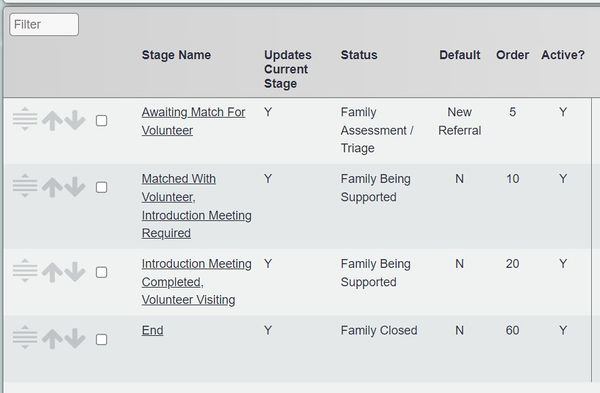Difference between revisions of "Home-Start Report"
(→Postcode Regions) |
(→Postcode Regions) |
||
| Line 30: | Line 30: | ||
*'''Closed''' - Reads from the '''"Family Closed"''' status | *'''Closed''' - Reads from the '''"Family Closed"''' status | ||
| − | [[File:home_start3.jpg| | + | [[File:home_start3.jpg|600px|alt="a screenshot of the list of stages."]] |
Latest revision as of 15:35, 21 November 2024
Contents
[hide]Postcode Regions
The Postcode Regions section gives you statistics of the families and family members who have gone through various stages during the time period, broken down into funded postcode areas. A family may appear more than once, for example supported then closed, as you do not want to exclude someone as being supported just because they were closed during the period as well.
What is the criteria for a supported family?
Examples are all based on a date range of 1st April to 30th June:
- Family Being Supported contact in May - Supported
- Family Being Supported contact in May, Family Closed contact in June - Supported and closed, as they were supported during the period and also closed
- Family Being Supported contact in March, with no further recorded contacts during the period - Supported, as there have been no other contacts recorded to say the family has stopped being supported. Families may be classed as being supported "passively", where support is available if they so desire but no active support is being provided
- Family Being Supported contact in February, Family Closed contact in March - Not supported, as we stopped supporting them before the period
- Family Being Supported contact in February, Not For NDR contact in March - Supported. This effectively the same as 3
Directly Supported - families and children in this section are only counted where they have an active Case during the report period.
Family Members 18 and Under - family members in this section are all family members that are linked to supported records in the "Directly Supported" section of the table, regardless of whether they have been supported or not.
Which postcodes count as funded can be set in the Funded Postcode Districts Extension Database found on the Our Services tab on your scheme's Home-Start record.
The three stages of support are counted via the statuses your referral stages are linked to:
- Awaiting support - Reads from the "Family Assessment / Triage" status
- Supported - Reads from the "Family being supported" status
- Closed - Reads from the "Family Closed" status
Children awaiting support - The number of family members under the age of 18 who had a status of "Family Assessment / Triage" directly on their record.
Supported Children - The number of family members under the age of 18 who had a status of "Family being supported" directly on their record.
Closed Children - The number of family members under the age of 18 who had a status of "Family Closed" directly on their record.
Families awaiting support - The number of families who had a status of "Family Assessment / Triage" directly on their record.
Supported Families - The number of families who had a status of "Family being supported" directly on their record.
Closed Families - The number of families who had a status of "Family Closed" directly on their record.
Families awaiting support BAME - The number of families who have a BAME Ethnicity/have a family member with a BAME Ethnicity who had a status of "Family Assessment / Triage" directly on their record.
Supported Families BAME - The number of families who have a BAME Ethnicity/have a family member with a BAME Ethnicity who had a status of "Family being supported" directly on their record.
Closed Families BAME - The number of families who have a BAME Ethnicity/have a family member with a BAME Ethnicity who had a status of "Family Closed" directly on their record.
Services
Comes from the Our Services Extension Database found on the Our Services tab on your scheme's Home-Start record
Referral Sources
Comes from the Referrer specified on the referrals. They will need the Organisation/People Category set on their record. Referrers with no category, or a category not listed in the NDR, are included in 'Other'
Number of Referrals Leading to Support Being Provided
Referrals during the date range, which at any point during or since, have had a contact which has a template stage linked to a status of 'Family Being Supported' or an attendance at a Club or Clinic
Family Needs
Comes from the referral reasons
Number of Supported Families During the Period Who Had Over 5 Needs
Comes from the referral reasons
Family Circumstances
Comes from the Family Circumstances Extension Database
Volunteers Providing Family Support
1. Volunteers who's latest contact, prior to the end of the period, used a stage with the status of Volunteer Is Active, or who had such a contact during the reporting period.
2. From the volunteers used for 1, this looks at the Volunteer Hours Logged Extension Database on the Volunteer record.
3. From the volunteers used for 1, this looks at the Volunteers with an Ethnicity set to BAME.
4. From the volunteers used for 1, this looks at the Age Bands.
5. From the volunteers used for 1, this looks at the Gender field.
6. From the volunteers used for 1, this looks at the Date started volunteering field in the Volunteer Extra Details Extension Database, and calculates how long they have been volunteering, based on the last day of the reporting period
7. Comes from the Completed HS prep Course field in the Volunteer Hours Logged Extension Database.
8. Comes from the Trustee field in the Volunteer Extra Details Extension Database.
9. Comes from the Previously supported by HS themselves field in the Volunteer Extra Details Extension Database.
10. Comes from the Access to Education, Access to Training and Access to Employment fields in the Volunteer Extra Details Extension Database.
The volunteers home-visiting and volunteers home-visiting & group queries now draw from hours logged as contacts with families as well as Extension Database entries.
GIRFEC (Scotland)
Comes from the GIRFEC Extension Database. Average improvement can be calculated on each indicator Calculation for non-improved is Total Assessed minus total of children across the + columns


